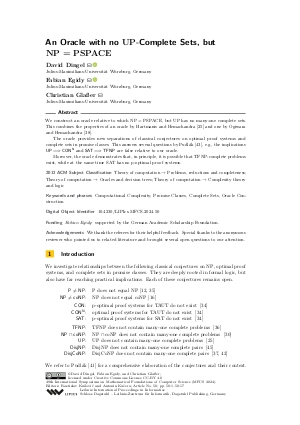LIPIcs.MFCS.2024.50.pdf
- Filesize: 0.85 MB
- 17 pages

 Creative Commons Attribution 4.0 International license
Creative Commons Attribution 4.0 International license

We construct an oracle relative to which NP = PSPACE, but UP has no many-one complete sets. This combines the properties of an oracle by Hartmanis and Hemachandra [J. Hartmanis and L. A. Hemachandra, 1988] and one by Ogiwara and Hemachandra [Ogiwara and Hemachandra, 1991]. The oracle provides new separations of classical conjectures on optimal proof systems and complete sets in promise classes. This answers several questions by Pudlák [P. Pudlák, 2017], e.g., the implications UP ⟹ CON^𝖭 and SAT ⟹ TFNP are false relative to our oracle. Moreover, the oracle demonstrates that, in principle, it is possible that TFNP-complete problems exist, while at the same time SAT has no p-optimal proof systems.











Feedback for Dagstuhl Publishing